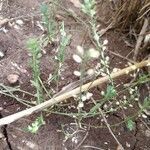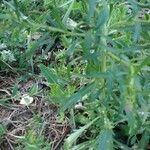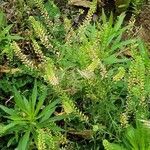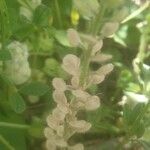Herbs annual or biennial, (10-)25-50(-65) cm tall, puberulent with minute straight papillae, rarely glabrous. Stems erect, branched above. Basal leaves rosulate, withered early; petiole 0.5-1.5(-2) cm; leaf blade often oblanceolate, rarely spatulate or oblong, (1.5-)2.5-8(-11) cm × 5-10(-20) mm, base attenuate, margin coarsely serrate or pinnatifid, apex acute. Cauline leaves shortly petiolate; leaf blade narrowly oblanceolate or linear, irregularly serrulate or dentate, rarely subentire, reduced in size upward. Infructescences dense; rachis papillae straight, slender or subclavate. Fruiting pedicels slender, divaricate, slightly recurved, somewhat flattened, (1.5-)2-3.5(-4) mm, puberulent or papillate adaxially. Sepals oblong, 0.5-0.8(-1) × 0.3-0.5 mm, glabrous or sparsely pilose near apex, margin white. Petals usually absent, rarely filiform and 0.3-0.9 mm. Stamens 2; filaments filiform, 0.6-1 mm; anthers ovate, 0.1-0.2 mm. Fruit obovate to obovate-suborbicular, (2-)2.5-3(-3.5) × 1.5-2.5(-3) mm, widest above middle, apex obtuse or emarginate; apical wings ca. 0.5 mm; apical notch 0.2-0.4 mm; style 0.1-0.2 mm, included in apical notch. Seeds brown, ovate, wingless or obscurely winged, 1.1-1.3(-1.5) × 0.8-0.9 mm; cotyledons incumbent. Fl. May-Jun, fr. Jun-Jul. 2n = 32.
Biennial. Stems ascending to erect, branching above, to 60 cm tall, with short, curved hairs, sometimes glabrous below. Lvs finely papillate at least beneath. Basal and lower stem lvs falling at fruiting, deeply toothed to pinnatifid. Upper lvs oblanceolate, toothed, becoming linear, entire or 3-fid at apex, 10-15-(30) × 1-2-(5) mm. Racemes (5)-8-12 cm long; rachis and upper side of pedicels shortly hairy; pedicels erecto-patent, 2-2.5 mm long at fruiting. Fls minute, densely crowded; sepals glabrous, green, c. 1 × 0.4 mm. Petals white, minute or 0. Stamens 2. Silicle c. 2.5 × 2-2.5 mm, circular to broadly obovate; style very short; stigma included in narrow notch; valves pale brown, glabrous. Seeds brown, ovoid, very narrowly winged, c. 1.2 mm long.
Thinly short-hairy annual or biennial, 2–5 dm; basal lvs 4–7 cm, coarsely dentate to pinnately lobed; cauline lvs shorter, linear or narrowly oblanceolate, mostly entire, sharply acute; mature racemes erect, 5–10 cm, with 9–15 frs per cm; pet none, or shorter than the sep, linear to narrowly spatulate; stamens 2; fr 2–3.3 mm, nearly or fully as wide, obovate-obcordate, generally broadest a little above the middle, narrowly winged above; stigma included in the notch; cotyledons incumbent; 2n=32. Dry or moist soil, waste grounds, roadsides, and pastures; throughout our range and w. to the Rocky Mts. May, June. (L. apetalum, misapplied; L. neglectum)
A cabbage family herb. It grows for one or two years. It is 25-50 cm tall. The leaves at the base are in a ring. The leaves on the stems are oblong and narrow. They are 3-8 cm long by 5-10 mm wide.




